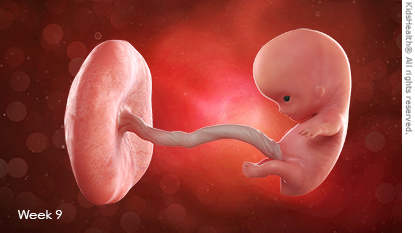- Home
- Humana Medicaid
- Kentucky Medicaid
- Medicaid extras
- Health and wellness
- Parents Home
- Para Padres
- A to Z Dictionary
- Allergy Center
- Asthma
- Cancer
- Diabetes
- Diseases & Conditions
- Doctors & Hospitals
- Emotions & Behavior
- First Aid & Safety
- Flu (Influenza)
- Food Allergies
- General Health
- Growth & Development
- Heart Health & Conditions
- Homework Help Center
- Infections
- Newborn Care
- Nutrition & Fitness
- Play & Learn
- Pregnancy Center
- Preventing Premature Birth
- Q&A
- School & Family Life
- Sports Medicine
- Teens Home
- Para Adolescentes
- Asthma
- Be Your Best Self
- Body & Skin Care
- Cancer
- Diabetes
- Diseases & Conditions
- Drugs & Alcohol
- Flu (Influenza)
- Homework Help
- Infections
- Managing Your Weight
- Medical Care 101
- Mental Health
- Nutrition & Fitness
- Q&A
- Safety & First Aid
- School, Jobs, & Friends
- Sexual Health
- Sports Medicine
- Stress & Coping
Pregnancy Calendar: Week 9
Your Baby's Development
The tail at the bottom of your baby's spinal cord has shrunk and almost disappeared by this week. In contrast, your baby's head has been growing — it's quite large compared with the rest of the body and it curves onto the chest.
By this week, your baby measures about 0.6 to 0.7 inches (16 to 18 millimeters) from crown to rump and weighs around 0.1 ounces (3 grams). The tip of the nose has developed and can be seen in profile, and flaps of skin over the eyes have begun to shape into eyelids, which will become more noticeable in the next few weeks.
The digestive system continues to develop. The anus is forming, and the intestines are growing longer. Internal reproductive features, such as testes and ovaries, start to form this week.
Your baby may make some first movements this week as muscles develop. If you had an ultrasound now, those movements might even be visible, but you won't be able to feel them for several more weeks.

Your Body
In preparation for your first prenatal visit, take the time to familiarize yourself with your family's health history and to review your medical records:
- Have you had any chronic illnesses, allergies, or surgeries?
- Are you taking any prescription medicines?
- Do you know of any genetic disorders that run in your family?
- Has your menstrual cycle been regular, and have you had any past pregnancies?
- What are your exercise habits?
These are some of the things your health care provider will want to discuss with you, so it will help to have this information ready when you go.

© 1995- The Nemours Foundation. KidsHealth® is a registered trademark of The Nemours Foundation. All rights reserved.
Images sourced by The Nemours Foundation and Getty Images.

